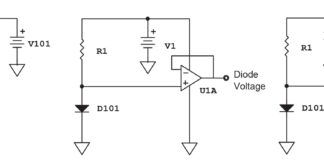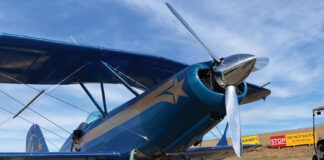Vans Aircraft is coming to the Light Sport market with the RV-12 rather late. There are already 80-some approved Light Sport aircraft out there, but this is the first RV LSA-an airplane emerging from a clean sheet, sketched and thoroughly tested by the folks from arguably the most successful kit company ever.
The RV-12 is offered as an ELSA, meaning you put it together. Everything from hardware to wiring harness is in the box. No poring through catalogs and web pages to outfit your project. In fact, you cannot modify the airplane unless you opt to build your RV under the amateur-built rules rather than assemble it under the ELSA rules. (And though its not a pure requirement for a 51% Experimental/Amateur-Built aircraft, the RV-12 is not yet on the approved list, though it is likely to be once the FAA resumes evaluations.)
Forget the yellow prototype you may have seen at airshows or in magazines last year. That airplane served its purpose as a test bed, providing valuable what-works/what-doesn’t information to the Vans design team and spawning the red production airplane (N412RV) flown for this article. One change included replacement of the steerable nosewheel with a castering one. This necessitated replacing the single, bicycle grip brake lever with more traditional independent toe brakes. Control sticks were re-shaped for better leg and belly clearance. The seats are now ground-adjustable fore and aft as well as back tilt. Oh, and the wing is completely different, owing to that pesky stall-speed requirement-getting it down to a real 45 knots CAS clean was not an easy task. Hard to argue with a well conceived and executed prototyping/testing plan.
Battling Weight, Cost
Weight is the airplane designers enemy-always has been. Vans battled this by minimizing heavier plastic or composite parts where aluminum would do, using the lighter Rotax 912ULS 100-horsepower engine instead of the heavier direct-drive stalwarts and a variety of numerous ounce-savers Im sure.
Cost is the customers enemy. Vans efforts here included the use of a Dynon FlightDEK-D180-a combined EFIS and engine monitor-display rather than individual flight and engine instruments, use of fuses instead of circuit breakers, and a concerted effort to ensure the plane could be assembled with simple hand tools. The sheet aluminum is joined by pull rivets pressed through holes that are not just pre-punched but punched to final size; no final sizing, deburring or dimpling.
Not unique enough yet? How about removable wings? I know, thats so 1990s, but Vans logic makes sense. The RV-12 is a day/VFR recreational vehicle that probably wont stray too far from home. Sure, you can keep it in your garage between flights, but a more likely scenario is you bring it home at the end of the flying season, or have your maintenance done there.
Wing attachment is a nifty two-pin affair. One wing at a time, you simply slide the spar into the only slot itll fit into until its end auto-locates into a receiver on the opposite fuselage wall. With both wings in place, the spars overlap all the way across the fuselage behind the seats. (This is an important design point, as the humans are seated ahead of the spar, not on top of it.) Insert two large-diameter pins through the fuselage attachment structure and both spars. The pins incorporate a spring-loaded lock to let you know they’re properly in place and preclude them from backing out unintentionally. An improperly attached spar illuminates a big red warning light on the instrument panel. When this light is on, the engine starter cannot be engaged. (OK, thats half true. Should you be having a really bad day and this light comes on in flight after an engine stoppage, you can push the light to override the starter lock-out.) As you’re feeding the spar into the fuselage, the flaperon torque tube slides into the actuating tube, while a tang is guided into its beveled receiver on the actuating tube. There’s one more alignment tang near the trailing edge that enters the only other slot on the fuselage. It doesn’t look like you can possibly get it wrong.
Wingtip lights may be offered as an option, and the wing attachment has provisions in the form of electrical contacts in the wingroots and fuselage that mate automatically with wing attachment. The test airplane had a stall vane on the left wing, and it used two of these contacts.
Two Wings, Lets Go
With the wings plugged in, we might as well fly. Cockpit entry is via welded steps just forward of each wingroot. Step, wing, cockpit floor-that simple. The forward-hinged canopy opens wide enough to let you stand straight up forward of the seat, but reaching the open canopy can be difficult while snugly strapped into the five-point harness. The canopy has a single locking handle centrally located on its trailing edge, which also allows you to leave it open a bit during taxi. Residents of Tucson rejoice.
Vans wanted a cockpit as roomy as the RV-7/9. At 41 inches across, measured at about lower bicep height, they got there. A mechanical flap lever resides in the 4 inches between the seats. The flap lever and control stick seem to be in the right place relative to the seat. Although the instrument panel is intentionally located more forward than I like, I could reach everything except the intercom control panel and the glove box on the right side of the panel. Loosening the upper restraint straps solved this issue. Full pedal required maximum extension of my short legs, but brake operation was easy.
The instrument panel is purposefully simple. The lone Dynon primary display provided all the information available except for the dedicated wing warning light and the fuse panel. According to Ken Krueger, Vans chief engineer, the fuses are designed to glow when blown. The fuse panel was an economic decision; I prefer circuit breakers.
Eight rocker switches line the lower instrument panel, and three were future options switches placarded INOP. The rockers look good, all in a row, the same style and nicely labeled, but the Rotax ignition rocker switches were unguarded. An argument could be made for the capability to secure the engine immediately, but an option that precludes an inadvertent shutdown seems stronger.
The first thing you notice when taxiing is the field of view, a full 360 horizontally with a little neck craning. Over the nose, you can see pavement as close as 30 to 40 feet ahead.
Understanding the Compromises
The airplane had a Sensenich, two-blade, ground-adjustable, composite propeller. Production kits will have a fixed-pitch, wood-core version. Setting the blade angle is always a compromise between climb and cruise performance. The maximum rpm developed during the takeoff roll was 5140-well shy of the engines 5800 redline. Still, the airplane was off the ground at 50 knots indicated airspeed (KIAS) about 11 seconds after power-up. Density altitude was 240 feet, and the wind was calm. (Although I wasn’t there, the editor reports that the RV-12 easily kept up with his GlaStar Sportsman photo ship during the initial takeoff roll, impressive considering the Sportsman has 210 hp. The bigger airplane pulled away once takeoff flaps were retracted.) Directional control during the takeoff roll was easy with the rudder effective as soon as the throttle was advanced. I lifted the nose passing through 40 KIAS, but it could have been sooner.
Immediately apparent were the low control stick and pedal forces. Stick pull during rotation was less than 5 pounds, using the recommended trim setting. While a different setting might increase the pull force, it could also create a control stick harmony issue, because the roll control forces are also small. Despite the low stick force, establishing the correct pitch attitude to capture the best climb speed of 75 KIAS was easy. Raising the flaps abruptly caused an abrupt, minor pitch-up of about 3, which was readily resolved with a little forward stick and click or two of trim. Yes, I said abrupt twice. In this airplane abrupt begets abrupt, and smooth begets smooth. Could be kind of nice-snappy, precise airplane response to control inputs when you want it, mild mannered when you want that. More on this later.
Average climb at best rate (5130 rpm at wide-open throttle) through 3300 feet density altitude was just over 700 feet per minute. Thats with the airplane loaded to max gross (1320 pounds) and the c.g. pushing the aft limit. Certainly respectable, but probably nowhere close to the climb available with the full 5800 rpm. Cruise flight evaluations used 5300 rpm. While 5500 is the max continuous allowed, the lower speed kept the oil temperature in the green. Vans is working on this. I flew a little quieter and slower (107 KIAS, 110 true) than you might. Tested cruise speed with the current prop is, according to the company, 114 KTAS at 70% power, a limitation set by the engine reaching max-continuous rpm before the throttle is fully in.
The field of view is wonderful. The bump on the cowl was about 15 below the horizon, and the downward view was progressively better as you moved your gaze aft to either side. The pilots eyes are probably at about the 15% chord point of the wing, making the look-down forward of the wing about 60 and maybe 30 looking cross cockpit. Over the wingtips the look-down is probably between 15 and 20. Providing Plexiglas aft of the rollover protection bar was a great idea, enabling the pilot to see the vertical tail and some of the same-side stabilator.
The test airplane flew right-wing-heavy, perhaps due to ballast boxes weighing 237 pounds occupying the space where the right seat should have been, and full fuel-20 gallons, call it another 117 pounds when full of 100LL-in the tank located behind the right seat. Letting the stick go in wings-level flight resulted in a 2/sec right wing down roll rate-easily countered with a tiny left stick force, but a bit annoying.
OK, more on those low control forces. The minimum force applied to the stick to start the airplane pitching or rolling is less than 1 pound in pitch and less than a half pound in roll. There’s no squeezing the black juice out of this stick. Interestingly, you don’t have to fly pinky-up either. Smooth control application generates smooth airplane response. This applies while flying in choppy air as well. Now Its Air In the Wings?
Because there’s nothing but air and structure in the wings, most of the planes mass is in its fuselage. Consequently, gust upsets tend to occur in the roll axis. Holding the stick too tightly can result in unintended stick inputs due simply to the inertia of your arm when the wind bumps a wing up or down a couple of degrees. A light hold on the stick helps. The build-up of stick force with increasing displacement is easily discernible. Couple this nice feel with the airplanes willingness to respond, and you have a predictable airplane thats fun to maneuver.
Full-span flaperons deflect differentially to help counter adverse yaw, and counter it they do. In fact, you really don’t need any coordinating rudder to roll the plane. Youll need it for coordinated turns once established in the bank angle, though. There’s plenty of roll rate-60/sec average, measured during 30 to 30 bank rolls. The airplanes roll mode time constant is short, meaning it quickly achieves the roll rate commanded by the stick displacement. Apply your stick input slowly for comfortable starts and stops, or do it quickly when you want to play fighter pilot.
Pitch response is similar but not as dramatic. How aggressively the airplane responds depends on how aggressively you move the stick. The airplane displays no persistent pitch wiggles when you stop making stick inputs. Its yaw response to pedal displacement is just as lively and as benign, and, yes, you can roll the plane with the pedals through its dihedral effect.
Trim Trials
It takes little stick pull or push to hold a deviation from the trimmed speed. With the plane trimmed for 107 KIAS, the stick pull to maintain 75 KIAS was about 4 pounds. It felt about the same when flying faster than the 107 KIAS trim speed. I suppose it might be a challenge to fly an exact off-trim speed for a prolonged period, but this isn’t how we fly. If you want to fly a different speed, the electric trim rate and sensitivity make quick work of trimming out the stick force. Maneuvering, the measured stick force was a pleasant 7 pounds/G, high enough to provide good feel and low enough to encourage aerial diversions en route to that burger.
Idle-power stalls occurred at 49 KIAS when approached with a 1 knot/sec deceleration. The stick pull increased steadily, reaching about 7 pounds just prior to stall. The warning horn whined (not loud enough in my opinion) at 56 KIAS and continued until recovery was initiated. Roll and yaw control remained effective throughout the stall approach. Although there was no significant increase in buffet, the horn and progressively increasing stick pull force provided some cues. The stall was a pitch break of about 15 accompanied by a right wing drop of 10 or so. Relaxing the pull recovered the plane immediately. Faster decelerations showed slower horn onset speed (53 KIAS) and apparent stall speed (45 KIAS), but the character remained the same.
Making a Flap
Selecting the first notch on the flap lever caused a slow nose-down pitch, which was easily prevented with a pound or two of back stick as the airspeed bled about 1 knot/sec. Going to landing flaps and slowing to the 55 KIAS recommended final approach speed had me pulling a light 4 to 5 pounds on the stick while maintaining level flight; 3 to 4 seconds on the trim switch took that away. Flap deflection is assured by looking at them. No ballooning, no big control force changes or direction reversals, no unusual attention required-nice. Pitch attitude is a little more nose-up here with the cowl bubble just below the horizon.
Adverse yaw shows up in this configuration, so you’ll use your feet again. It took me a few turns to calibrate the low pedal force requirements, but they soon became second nature. Use enough pedal to feel right while rolling, then back off a tad once established in the bank.
Lateral control friction also shows up with the flaperons deflected. Vans is working on this, too. Its enough that the stick will only return to within an inch of where it was before it was displaced. Problem? No, at least not for day, VFR flying. The abrupt roll mode seen in cruise softens under landing pattern conditions, making for nice predictability while generating the 30/sec roll rate available here. Don’t relinquish that light touch on the control stick; a level, 30 bank turn takes only 3 pounds of pull.
The static stability gradient remained shallow, meaning there wont be a lot of stick force cues to let you know you’ve wandered away from the 55 KIAS you trimmed for. It takes less than 2 pounds of stick pull to fly slow enough to trigger the stall warning horn and probably 5 or 6 pounds of push to reach the max-flap speed. This means you will have to keep a close eye on the airspeed indicator in the pattern.
Stalls with the flaperons in the landing position aren’t much different from the clean stalls. Stick force increases to the 4- to 5-pound range, and the warning horn starts singing at about 49 KIAS. Stall speeds were in the low 40s with the Dynon indicator bouncing a couple of knots in both directions.
Balanced flight is not that critical at the 55 KIAS final approach speed. Full pedal slips were easy to perform, which is good, because the airplane is not that eager to come down. Even with the throttle held at idle (and you must, or itll creep forward), the timed descent rate was 600 fpm. Flying at 55 KIAS in a full-pedal slip, the rate increased to 720 fpm. Not a dramatic increase, but it helped. Controllability and airspeed control are no different in the slip.
The airplanes reluctance to come down meant either a somewhat flat final approach or using a forward slip. Either works fine, but the slip is more fun. Entering the landing flare with much more than the recommended 55 KIAS results in an impressive ground effect float. You can put it down at any time, but youd lose the satisfaction of hearing the stall warning horn come on just prior to the wheel chirp. And you don’t have to quit flying just because the mains are down. Nursing the stick fully aft keeps the nosewheel up until about 27 KIAS on the Dynon, after which it self-lowers gently to the runway.
Control forces throughout the landing pattern are, well, by now you know-low. Minor gust upsets that raise a wing can be fixed in short order with intuitive stick and pedal corrections. Tracking the runway centerline on final, through the flare and during roll-out comes automatically. In short, the plane is a delight in the pattern-at least in light, variable wind conditions.
So what we have here is a marvelous contradiction. You might expect a lightweight airplane with low control forces and lively response to be difficult to keep on a particular condition such as attitude or altitude or speed. It aint so. The RV-12 is easy to fly and well behaved. It might be late to the LSA party, but I suspect itll be an honored guest.
For more information, call 503/678-6545, or visit http://www.vansaircraft.com/.




